*The values used in our calculations for this article are for the years 2022-2023.
In this article, we’ll examine whether 25 MPG, or 9.4 L/100 km, is a reasonable fuel economy for a general automobile, and then we will discuss 25 MPG for different categories of vehicles.
The focus will be on combined fuel economy. We will, however, briefly discuss city and highway fuel economy.
Is 25 MPG Good?
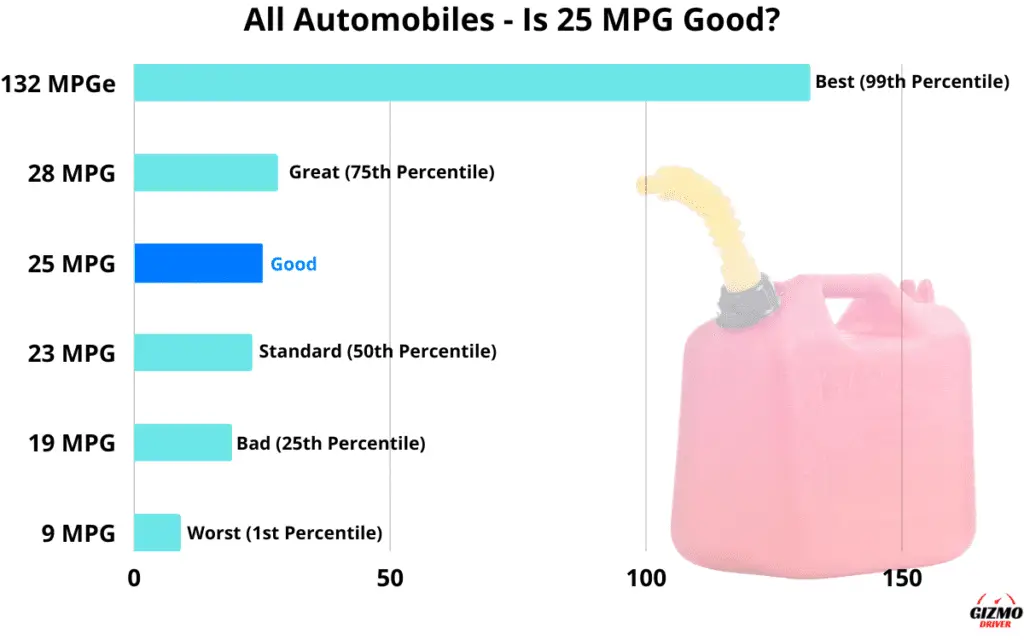
Summary:
25 miles per gallon is considered good gas mileage. It is 2 MPG higher than the median (50th percentile) fuel economy for all passenger vehicles, which is 23 miles per gallon. For specific vehicle types, 25 MPG is good for large SUVs, pickup trucks, sports cars, and large sedans.
The table below shows how good 25 MPG is for different types of vehicles:
| Vehicle Type | Median Fuel Economy | 25 MPG is | 25 MPG/Median Difference |
|---|---|---|---|
| All Automobiles | 23 | Good | 8.70% |
| Sedan | 28 | Not Good | – 10.71% |
| Small SUV | 27 | Substandard | – 7.41% |
| Large SUV | 21 | Excellent | + 19.05% |
| Sports Cars | 19 | Exceptional | + 31.58% |
| Pickup Truck | 18 | Exceptional | + 38.89% |

As we can see in this chart, 25 MPG is average for compact SUVs (crossover) and above the 50th percentile for 6 of the major vehicle categories: full-size SUVs, full-size pickup trucks, sports cars (coupes), mid-size pickup trucks, mid-size SUVs, and full-size sedans.
The median is a better measure of assessing whether or not 25 MPG is good. Electric vehicles and plug-in hybrids can significantly inflate average gas mileage values.
For example, we calculated that a pickup truck’s average (mean) MPG is 20.6 miles per gallon. However, 20.6 MPG is above the 70th percentile for all pickup trucks. That means for every 10 pickup trucks, 7 get lower gas mileage than the average of 20.6.
The median MPG, or 50th percentile, much better reconciles the large efficiency gap between electric and gas-powered vehicles.
25 MPG City
25 MPG in the city is considered great. It is 5 MPG, or 25% better than the gas mileage of the median car (50th percentile), which gets average gas mileage of 20 MPG in the city. The median city fuel economy for a hybrid car (MHEV/HEV) is 23 MPG.
Usually, fuel efficiency in city traffic is worse than on the highway. Full-hybrid vehicles, on the other hand, are often more efficient in the city than on the highway due to regenerative braking systems.
25 MPG Highway
25 MPG on the highway is not a good fuel economy. It is 2 miles per gallon lower than the 50th percentile of highway fuel economy, which is 27 MPG. For most vehicles, 25 MPG on the highway translates to 20-21 MPG combined (city and highway), which is also considered substandard.
The cost of 25 MPG
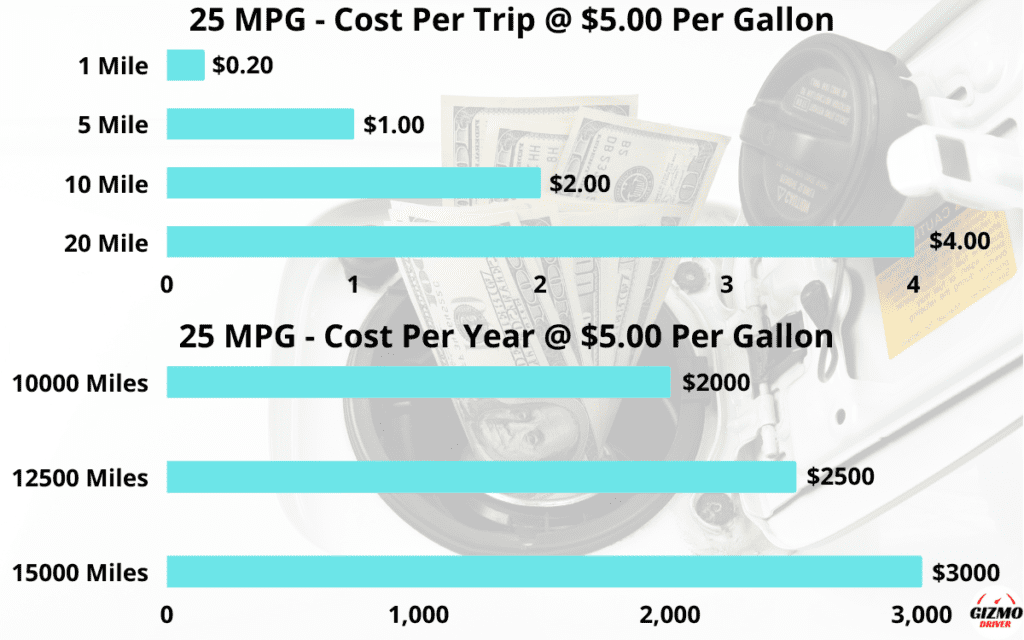
At 25 MPG, you’re spending around an average amount of money on fuel.
At $5.00 per gallon, a vehicle that gets 25 MPG will generally cost you $0.20 per mile. A 15-mile commute to work will cost you $3.00 in gas.
When driving 15,000 miles per year, the annual cost of fuel for a car that gets 25 MPG is $3,000. Gas mileage of 25 MPG would have you spend, on average, $260 less on fuel than the average person would.
How many miles is 25 MPG
MPG indicates how many miles your car can travel on one gallon of fuel. If your vehicle gets 25 MPG, it can travel 25 miles for each gallon of fuel. A vehicle with a fuel tank capacity of 15 gallons and a gas mileage of 25 MPG can travel up to 375 miles before needing to refuel.
25 MPG in L/100 km
25 MPG is 9.4 L /100 km. That means you burn 9.4 liters of gas for every 100 kilometers driven.
At 9.4 L/100 km, you can go 10.64 km with one liter of gas.
25 MPG on SUVs

In general, gas mileage of 25 MPG is considered above average for SUVs. But, just like with any other type of vehicle, there are a lot of things to consider before determining if 25 MPG is a good fuel economy for any given SUV. The biggest factor is the size of the SUV, which we will look further into.
For instance, 25 MPG might be great for a mid-size SUV with a V6 engine, but terrible for a compact hybrid SUV with only 4 cylinders.
There are 2 main categories and 4 subcategories for SUVs: full-size and mid-size SUVs fall into the large SUV category, while compact and subcompact SUVs fall into the small SUV category.
To get a better idea of what you can consider good fuel economy for an SUV, please check out our articles covering the fuel economies of large SUVs and small SUVs.
We’ll take a look at each subcategory.
Full-size SUVs:
25 MPG is about the best fuel economy you can get with a full-size SUV. That’s 47% more miles per gallon than the median for the segment, which is 17 miles per gallon. A full-size SUV that gets 25 MPG is better than more than 99% of full-size SUVs.
25 MPG or above is usually seen in the most fuel-efficient full-size SUVs, typically fitted with diesel engines.
The 2023 3.0 L, 6-cylinder diesel Chevrolet Tahoe (2WD), which has a gas mileage of 24 MPG, is one of the few full-sized SUVs that can achieve an average gas mileage of 25 MPG if driven carefully.
Mid-size SUVs:
For a mid-size SUV, 25 MPG is considered great gas mileage, as it is above the 75th percentile of fuel economy for all mid-size SUVs. The median fuel economy for this segment is 21 miles per gallon.
25 MPG is usually seen in 4-cylinder mid-size SUVs. The median fuel economy for 4-cylinder mid-sized SUVs is 23 MPG.
An SUV that gets 25 miles per gallon is the 2023 AWD Volvo XC90 B5, with a 2.0 L, 4-cylinder engine.
Compact SUVs:
For compact SUVs, gas mileage of 25 MPG is standard. It is the 50th percentile of the gas mileage for all compact SUVs. Most of these vehicles will get between 23 MPG and 32 MPG (25th and 75th percentiles).
25 MPG is most often seen in the most fuel-efficient 6-cylinder and least fuel-efficient 4-cylinder compact SUVs.
An example of a compact SUV that gets 25 MPG is the 2023 2.5 L, 4-cylinder Kia Sportage.
Subcompact SUVs:
25 miles per gallon is bad gas mileage for a subcompact SUV. It is below the 25th percentile for this segment. The average (median) gas mileage for a subcompact SUV is 30 miles per gallon.
25 MPG is typically seen in the performance variants of these vehicles.
The 2023 2.0 L, 4-cylinder Subaru AWD CrossTrek is an example of a subcompact SUV that gets 25 MPG.
25 MPG on Pick-up Trucks
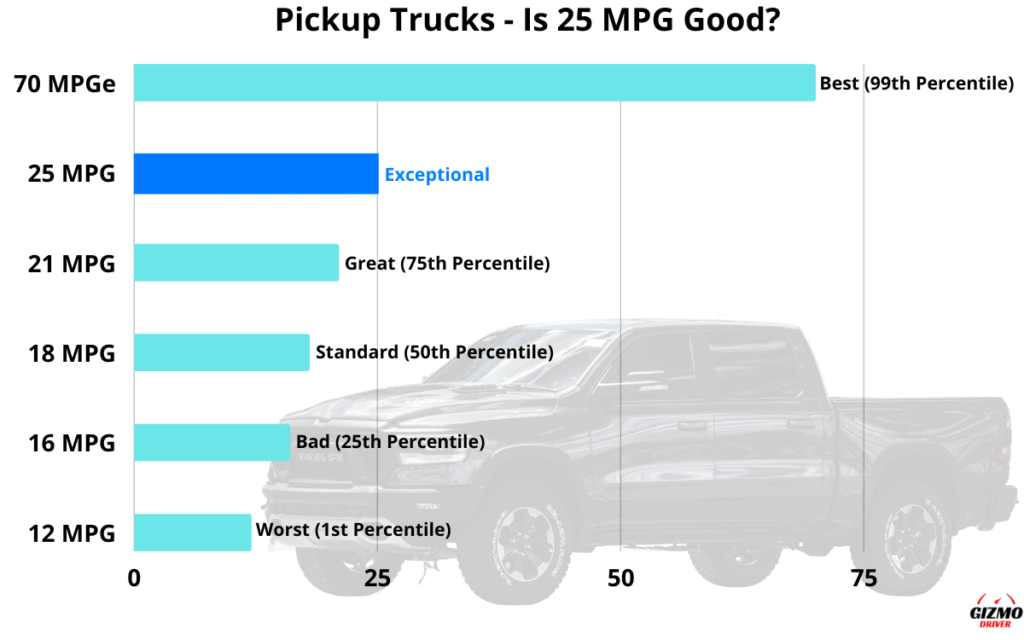
25 MPG is an excellent gas mileage for the average pickup truck. A pickup truck with gas mileage of 25 MPG is in the 95th percentile for this segment.
25 MPG is generally seen in hybrid pickup trucks or ones with diesel engines. The average fuel economy for all diesel pickup trucks is 24 MPG.
An example of a full-size pickup truck that gets 25 MPG is the 2WD Ford F-150 Hybrid, which houses a 3.5 L, 6-cylinder engine.
To get a better idea of what you can consider good fuel economy for pickup trucks, please check out our articles covering the fuel economies of mid-size and full-size pickup trucks.
25 MPG on Sedans
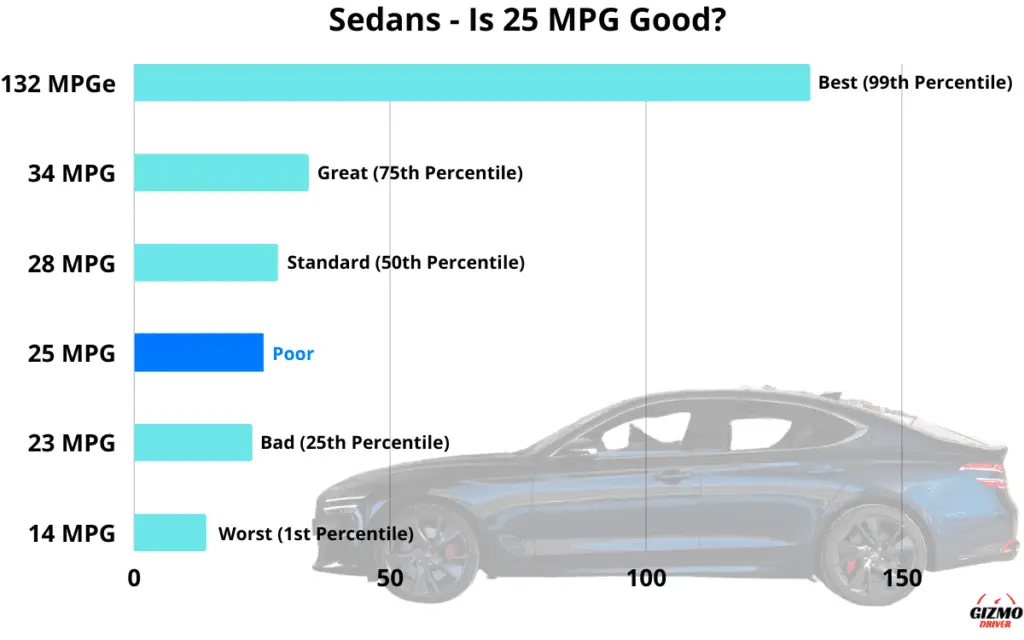
As we can see in the above chart, which illustrates the different percentile ranges for sedans, 25 MPG is considered substandard gas mileage for sedans in general.
Of course, the answer will vary depending on the type of sedan being driven. For example, 25 MPG could be great for a V6-powered performance sedan, but terrible for a small hybrid sedan with a four-cylinder engine.
To get a better idea of what you can consider good fuel economy for sedans, please see our article covering the fuel economies of every type of sedan vehicle.
Full-size sedans:
25 MPG is considered great gas mileage for full-size sedans. It is 4 miles per gallon higher than the median for the segment, which is 21 MPG. Full-size sedans typically get gas mileage between 19 and 25 MPG (25th and 75th percentiles). Anything below this range is bad, while anything above is great.
For full-size sedans, you can generally expect 6-cylinder hybrids or 4-cylinder engines to do 25 MPG.
The Lexus LS 500h AWD, which has a 3.5 L, 6-cylinder engine, is an example of a full-size sedan that does 25 miles per gallon.
Mid-size sedans:
25 MPG is considered okay for a mid-size sedan. The median fuel economy for a mid-size is 26 MPG, which is 4% higher than 25 MPG.
Most mid-size sedans that get 25 MPG are 6-cylinder sedans or 4-cylinder luxury/performance sedans.
An example of a mid-size sedan with gas mileage of 25 MPG is the 2023 2.5 L, 4-cylinder AWD Kia Stinger.
Small sedans (including hatchbacks):
25 MPG is terrible fuel economy for compact sedans or hatchbacks. These cars normally do between 28 and 35 miles per gallon, with the median being 31.5 miles per gallon.
Much like subcompact SUVs, 25 MPG is a rare sight in compact-to-subcompact 4/5-door cars.
The 2023 2.0 L, 4-cylinder Mercedes-Benz AMG A35 4matic is an example of a small sedan with an EPA rating of 25 miles per gallon.
Please note that for our calculations, we’ve counted some luxury sedans labeled as compact sedans (such as the Mercedes C-Class, Genesis G70, or BMW 3 Series) as mid-size sedans. These cars are much closer in size to other conventional mid-size sedans.
25 MPG on Sports Cars
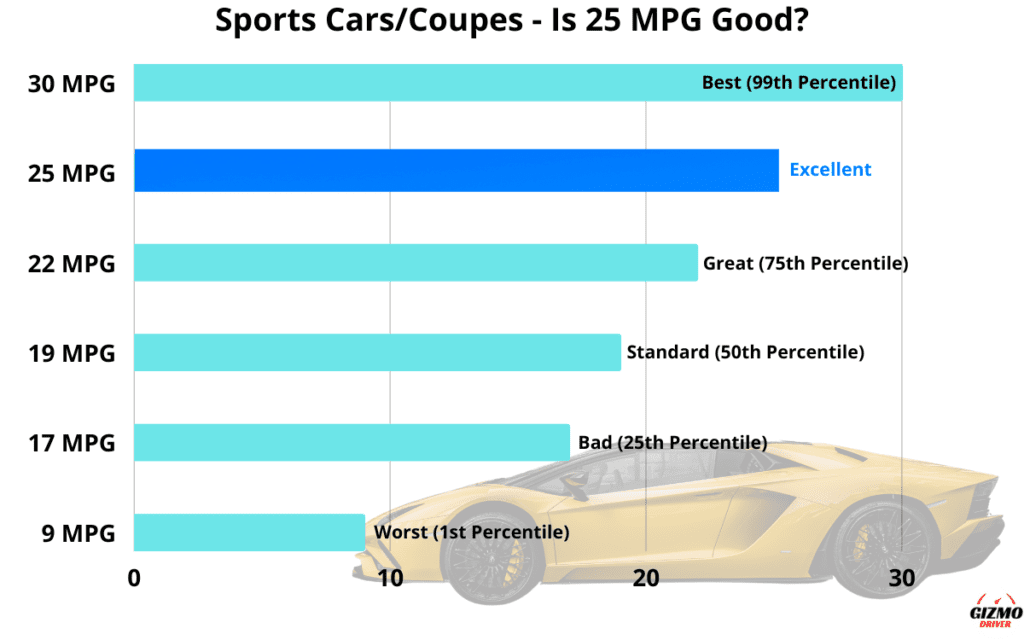
25 MPG is well above the 75th percentile for sports cars and is considered excellent gas mileage. The median sports car does 19 miles per gallon.
25 miles per gallon is excellent gas mileage for sports cars with large V8, V10, V12, or W16 engines; it’s great for 6-cylinder sports cars; it’s normal for those with 4-cylinder engines. A 4-cylinder sports car’s average fuel economy is 25 mpg.
A sports car that gets 25 MPG is the 2023 2.4 L, 4-cylinder Subaru BRZ.
Conclusion
To conclude, 25 MPG is considered good gas mileage for most cars. For pickup trucks, full-size sedans, large SUVs, and sports cars, gas mileages of 25 MPG are considered excellent; for small SUVs and sedans, it is considered poor.

